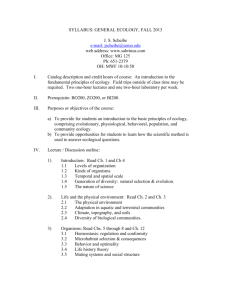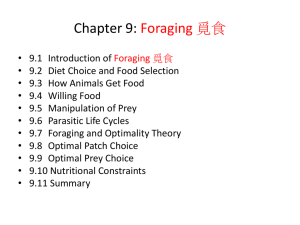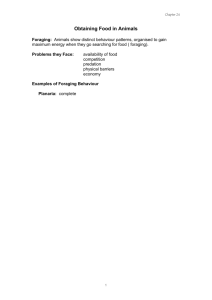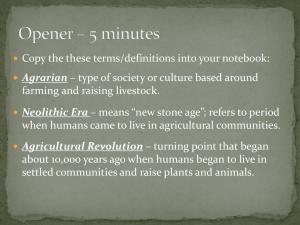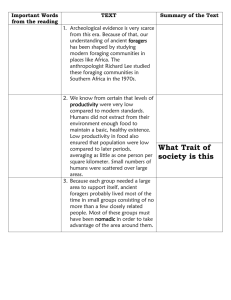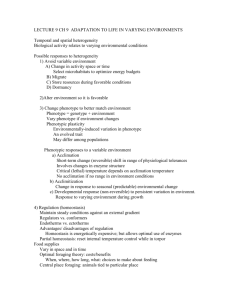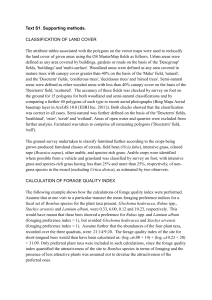Balancing Costs and Rewards in Making Foraging Decisions
advertisement
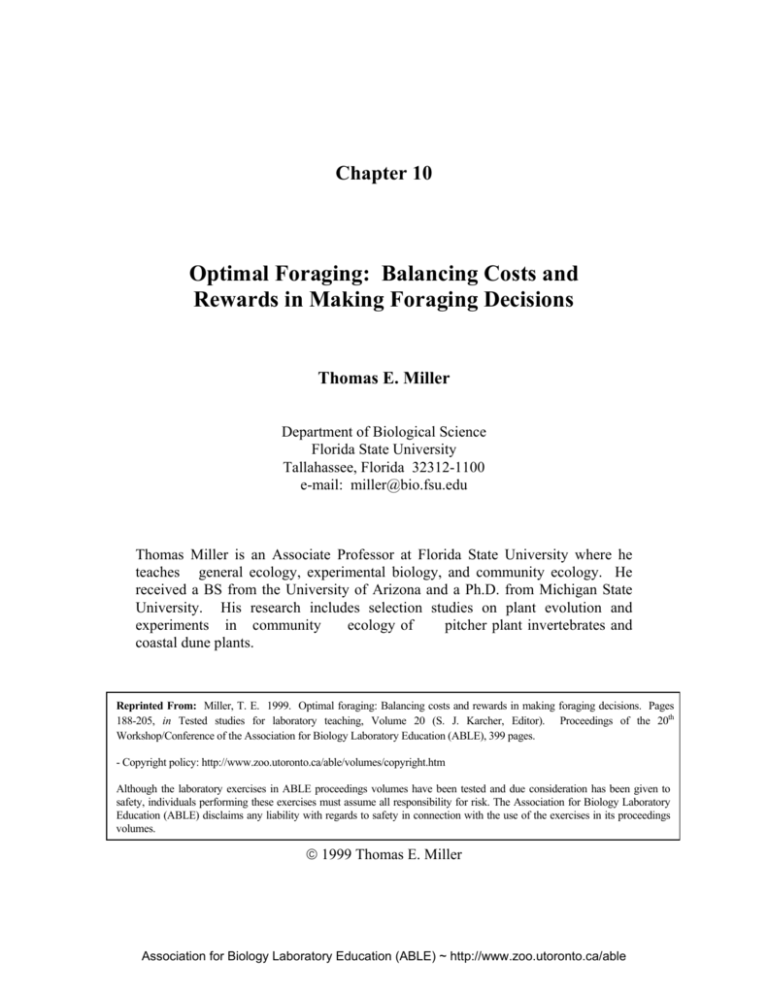
Chapter 10 Optimal Foraging: Balancing Costs and Rewards in Making Foraging Decisions Thomas E. Miller Department of Biological Science Florida State University Tallahassee, Florida 32312-1100 e-mail: miller@bio.fsu.edu Thomas Miller is an Associate Professor at Florida State University where he teaches general ecology, experimental biology, and community ecology. He received a BS from the University of Arizona and a Ph.D. from Michigan State University. His research includes selection studies on plant evolution and experiments in community ecology of pitcher plant invertebrates and coastal dune plants. Reprinted From: Miller, T. E. 1999. Optimal foraging: Balancing costs and rewards in making foraging decisions. Pages 188-205, in Tested studies for laboratory teaching, Volume 20 (S. J. Karcher, Editor). Proceedings of the 20th Workshop/Conference of the Association for Biology Laboratory Education (ABLE), 399 pages. - Copyright policy: http://www.zoo.utoronto.ca/able/volumes/copyright.htm Although the laboratory exercises in ABLE proceedings volumes have been tested and due consideration has been given to safety, individuals performing these exercises must assume all responsibility for risk. The Association for Biology Laboratory Education (ABLE) disclaims any liability with regards to safety in connection with the use of the exercises in its proceedings volumes. © 1999 Thomas E. Miller Association for Biology Laboratory Education (ABLE) ~ http://www.zoo.utoronto.ca/able 188 Optimal Foraging Contents Introduction....................................................................................................188 Materials ........................................................................................................189 Notes for the Instructor ..................................................................................190 Student Outline ..............................................................................................192 Introduction....................................................................................................192 Exercise 1: Simple Choice Foraging with the computer program BEE! .....192 Exercise 2: Foraging in patches ....................................................................197 Acknowledgments..........................................................................................205 Literature Cited ..............................................................................................205 Introduction This laboratory consists of two related exercises dealing with the same subject: how foragers make decisions. The two exercises were developed to be done as a single lab, but can be conducted separately. The main concept behind the exercises is that behaviors of organisms are neither random, nor are they “hard-wired.” Instead, behaviors are the result of numerous decision-making situations, where the sum of all the decisions ultimately can determine the success of the individual. I have generally had the students do the computer exercise (Part 1) before the lab and then do the patch foraging experiment (Part 2) in the lab. We require the students to turn in reports on each, but the instructor in class as a demonstration could also analyze the data for Part 2. Foraging ecology is a very rich area of research, with great examples to which students can easily relate. It also has the advantage that it can be presented at many different levels, from very basic to extremely complex. I usually start by making students realize that most of their own behaviors can be understood as foraging. Everything from choosing socks in the morning, grocery shopping, selecting classes, to picking up dates in bars can be reduced to the same set of foraging questions. The next step is to make students think about the fact that some foraging decisions result in better outcomes than do others and that the sum of these decisions determines much of their life. The goals of this lab are to get students (1) to recognize that organisms are making decisions about food, shelter, and mating all the time and that these decisions determine the fitness of organisms and (2) to use basic scientific method and some simple mathematical models to predict “optimal behavior” and (3) to test how well real foraging matches up with the optimal foraging. For more background information, most standard ecology textbooks have a good section on foraging theory: I particularly recommend the section on optimal foraging in Begon, Harper, and Townsend’s Ecology (1996). There is also some “fun” primary literature on foraging that is pretty accessible to students, such as foraging studies done with squirrels eating cookies (Lima and Valone 1986), feeding ducks (Harper 1982), and bees on mints (Sih and Baltus 1987). Part 1 of this lab is very basic and can be presented to almost any level of student. It utilizes a computer program I have written called “BEE!” and requires about 1 to 1.5 hours to complete. This program simulates a bee foraging in a field of flowers. The student decides which flower the bee should next visit; each flower type has different rewards and different densities (which are related to costs of travel). We have the students try a couple of “sub-optimal” foraging behaviors first, to make students realize that foraging decisions will not usually be simple and that decisions require balancing a constantly changing set of costs and benefits. Students then Optimal Foraging 189 try to come up with simple “rules” that might yield a higher foraging rate than either of the suboptimal behaviors. Then they must forage by their rules and compare their results with the foraging efficiency of the previous sub-optimal strategies. There is no set-up for this lab, but a computer lab or other individual access to computers is required. There are two versions of the program available: a MacIntosh version by T. Miller and a Windows version by Alex Stuy. Both programs are very simple and available free from me (shareware, see below). The second portion of the lab is conceptually and mathematically more difficult and can require 2 -3 hours. The scenario has added a larger-scale spatial component to understand foragers that stay for extended periods of time in areas of high resource concentration (patches) with occasional movement from one patch to another. Think of a bee going from one patch of flowers to another (or an undergraduate going from one bar to another looking for a date). It requires first presenting a graphical model of the marginal value theorem to students. This theory uses information about foraging behavior to predict how foragers should move among patches. The students then get to act as foragers, by searching for prey (usually beads) in resource patches (5 gallon buckets) that are spread out in a lawn or hallway. The beads are buried in some matrix, such as sand or rice, and the buckets are spread far apart to create “costs” for the foragers moving from patch to patch. The students try to forage in a way that maximizes the rewards taken per unit time, while their classmates take data on their behavior. The data can then be used to predict what the students should have done if they were foraging optimally. The entire exercise can be discussed and compared to real patch foraging such as bees among flower stalks or wolves moving among wood lots. I modified the patch foraging exercise laboratory from a similar exercise used by Andy Sih of the University of Kentucky and Gary Mittelbach of Michigan State University. Materials Part 1: Computer exercise: • • • BEE! available as shareware by contacting T. Miller. The program can also be downloaded from the internet at: (http://bio.fsu.edu/~miller/PROGRAMS/MiscPrograms.html). Availability of one computer per student, either in a computer laboratory or as an outside assignment. Data sheets and a calculator to do simple addition and division. Part 2: Foraging in a patchy environment Needed for every six students: • A set of four 5-gallon buckets. Each bucket should be about 2/3 filled with some medium such as rice, vermiculite, or sand (a bit hard on the hands). If you use rice, this amounts to about 11 to 16 kg of rice per bucket. • Four small “collecting cup” to hold the prey as they are captured from each bucket. • 60+ “prey.” Large beads or beans work well. Double this number for a set of “high productivity" buckets. Needed for every three students: • 1 stopwatch • Data sheets for each of the three students • 1 clipboard 190 Optimal Foraging • 1 pencil Notes for the Instructor Part 1: Computer exercise: 1. This exercise can either be done as a group in a computer lab or assigned as an outside project to be done before Part 2. The work is self-directed, although a little help from the instructor at the beginning can help to get things going. I intentionally did not have the program analyze any of the data for the student (calculate means, etc.) because I wanted the students to deal with their own data, as if it were obtained from actual observations in the field. 2. The program creates random spatial patterns of flowers, with a set number of each type of flower. The benefits depend entirely on the type of flower. Once a flower is visited, the pollinator removes all the nectar. The flower does not refill, which discourages foragers from backtracking. The costs of moving are simply determined as the distance between the flowers, which presumably reflects energetic costs of flying. Part 2: Foraging in a patchy environment 1. This is a good lab to get students moving and working together. I conduct the exercise on the lawn nearest to my classroom. This arrangement can be done in a hallway if rain or cold weather require the lab be conducted indoors. 2. There are four buckets per 2 groups and three students in each group. I use five-gallon pickle buckets that are frequently available for free from fast-food restaurants. Each bucket needs to be filled about 2/3 full of some media that hides the beads. Both vermiculite and rice work well; sand is usually too rough. I use red kidney beans as prey and hide them among the rice. For each series of four buckets, there are three unlabeled buckets: low (5 prey), medium (15 prey), and high (25 prey) buckets. A fourth bucket, labeled “average,” contains 15 prey. These numbers should not be revealed to the students until they are finished. The prey need to be reburied in each bucket before a student “forages” in the series. (These prey densities may need to be changed depending on the media and the type of prey used). 3. The buckets should be placed so that there is significant travel time between them. I usually take the buckets out to a nearby lawn and put the average bucket and a random one of the others at the start. The other two buckets are then placed about 25 meters away. 4. Students work in groups of three: one student will be a forager, with a second student calling off times from the stopwatch and the third student writing down the times on the data sheet. Students then rotate jobs until each has had a chance to forage in the full series of buckets. 5. All foraging must be done with a single hand. A student is required to hold each captured prey high over his head, shout "found one", and then place the prey in the available cup. This mimics handling time and gives the recorder time to record the capture time. Each Optimal Foraging 191 student will be required first to play in the “average” bucket, getting a feel for foraging. Then the student should re-mix all the prey back into the average bucket and be monitored as he forages in the bucket until all or most of the prey have been taken. This provides data for the general foraging curve for this student. 6. Each student does a single foraging bout across all three of the other buckets. Beginning at the first two buckets, the student must first walk (no running allowed!) to the next bucket and begin to forage. When the student decides that the return rate from that bucket is too low, the student should leave that bucket and walk back to the next bucket (back near the start). When the student feels that the return rate again is too low, he should proceed to the final bucket and forage until he thinks that again he should move on. At this point, the student calls “stop” and his foraging is finished. The other two students are responsible for keeping track of the start time, the arrival time and departure time at each set of buckets, and the time at which each prey is capture. Then the students rotate jobs to allow one of the other two to complete the foraging. A final bout allows the third student to complete the exercise. 7. To minimize the number of buckets used, we have two groups of three students assigned to each set of buckets. Stagger the starting times such that when one group leaves the second bucket in the series, the other group can begin at the first bucket. 8. The instructor and TA are responsible for keeping the prey mixed back into the buckets before each forager runs through his series of “patches.” The instructor and TA are also responsible for enforcing the no-running and one-hand rules. 9. There are several different options for bucket "set-ups." As designed above, the class will be able to see that bucket density affects the optimal "give-up time." Basically, students should stay longer at high density than at low density buckets. Further, the interval time between captures when the student decides to leave should be about the same at all buckets, regardless of their initial prey density. There are at least two other interesting ways to set up the buckets, which might be illustrative if you have enough students to generate strong patterns in the results. First, you might simply put all three buckets near or far from one another. If students forage "optimally," they should be more willing to give up and move to the next bucket if the cost (distance) is low. Second, you could have series of buckets with different average prey number. Students in the high-prey series of buckets should stay longer in each patch, as long as the costs remain the same. I encourage you to think of other ways to test the general theory laid out in the laboratory introduction (I've thought of trying to increases costs by making some students conduct the exercise on one leg!). 192 Optimal Foraging Student Outline Foraging Ecology: Thinking like a forager Foraging ecology encompasses all the behaviors that go with obtaining resources. Thus, the study of foraging ecology must begin with understanding resources. If those resources are other living things that are consumed, we call it predation, but foraging ecology includes obtaining many other types of resources. For example, animals frequently forage for shelter, to avoid either predation or harsh elements. Plants may “search” for nitrogen in the soil by determining where to put their roots. Another very important resource is a sexual partner: foraging for mates is a primary consideration for many, if not most, species. Foraging can also occur for nest sites or homes (hermit crabs); flowers even “forage” for pollinators. Consider humans and the many ways we forage every day. This includes foraging for food, which might include digging around in the refrigerator for non-moldy leftovers or the long term planning of shopping for bargains at different grocery stores. You probably have all foraged for shelter, dealing with repugnant landlords, noisy neighbors, and monthly rents. You might also go bar hopping to forage for mates. And, of course, there is the other big one: foraging for money by working. The “big three” resources are usually food, shelter, and mates, but stored goods such as money can be used to obtain all three of the other resources. Human foraging essentially never stops, and may include many mundane things such as trying to get in the right classes or searching shoe stores for that perfect shoe at the right price or even foraging for the matching sock in you dirty laundry. All these behaviors can be loosely incorporated into foraging ecology and all share a number of similar concerns, constraints, and behaviors. Ecologists formalize these types of behaviors using mathematical models that divide behaviors into benefits and costs of different decisions. They then can predict what the “best” decision is for the forager, based on some combination of high benefit and low cost. This approach is generally known as optimal foraging theory because it attempts to determine the optimal or best possible foraging behavior. This lab consists of two related exercises that investigate optimal foraging models. The first will look at simple choice models, where the forager must choose between resource items that have different costs and benefits. The second exercise considers the more complex situation of a forager moving among different patches of resources. Exercise 1 - Simple Choice Foraging with BEE! The most obvious decision that must be made by foragers is what to try to capture and consume and what to ignore. A predator, for example, must decide which of the many possible prey in its environment should be pursued and consumed. Some prey simply won’t provide any nutrition and others cannot be caught; these are not really options. But the predator must choose among the remaining prey, which differ in both their nutritional value and the amount of effort needed to capture and consume them. It is much like choosing items off a menu in a Chinese restaurant. You avoid certain items on the menu simply because you have no idea what they are. You avoid others because you had them last time and hated them. Still other items are just too expensive for your limited budget. You choose among the remaining items on the basis of factors like the quantity, price, and taste of the food. Optimal Foraging 193 We can develop equations to predict the consequences of different menu (diet) choices. Basically, we try to quantify the benefits (e.g., quantity and taste of food) and the costs (e.g., price) of the food and use these numbers to predict which food should be taken and which should be ignored. A predator, for example, may weigh the benefits in terms of calories against the costs in terms of subduing its prey. In all cases, we are trying to figure out which are the best or optimal sorts of decisions available to predators. We can then test our predictions by actually watching what the predator consumes in different circumstances. Bee!: Using the Foraging Program As an introduction to foraging, we want you to try to think like a bee. Pollinators visit flowers to collect rewards (and incidentally to carry out pollen transfer). Pollinators do not collect resources haphazardly; rather their behavior has been molded by natural selection to maximize their efficiency. The bee that can collect the most energy per unit time will have more energy to contribute to its hive and more time to spend on other activities. The goal of this exercise is to allow you to explore foraging strategies that pollinators may use in maximizing their efficiency. Efficiency is usually quantified by the ratio of benefits obtained while foraging to costs incurred. A forager that achieves a higher ratio of benefits to costs is said to be more "efficient." For pollinators, the benefits can be measured by the amount of reward they collect. Their costs can be measured by the energy they must expend flying from flower to flower collecting this reward. As you complete this assignment, think about how you might explore some of these ideas in the real world. How could you measure costs and benefits? How could you figure out what cues and what rules are used by a butterfly or bee to decide what flower to visit next in a field of flowers? The program you will use for this exercise is called "Bee!" The instructor will tell you how to obtain access to this program. When the program is running, the right-hand side of the screen will show a bee in a field of flowers. To the left is a box labeled "Foraging Data." The program allows you to direct the bee and to forage for nectar rewards on the flowers in the field. Each time you click on a flower, the bee will "fly" over and visit that flower and collect its reward (try it!). Each time you visit a flower, the box on the left side of the screen will show you how much of a reward you collected and how much it cost you to get that reward. The cost is determined only by how far you had to fly to reach the flower, not by the type of flower. The six types of flowers differ in the amount of reward they offer (1 to 10 units) and in their abundance. A given flower type always gives the same reward unless the flower has previously been visited. Once you visit an individual flower, its reward is gone and, if you revisit that same flower, you will not get any benefit. The basic problem facing you (in your role as a bee) is to decide which flowers to visit and in what order. If you have some previous knowledge of this flower community, you can consider a variety of important factors, including amount of nectar or pollen (related to benefit), how difficult it is to obtain that nectar or pollen (related to cost), distance to or density of your flower type (related to cost). Other factors may also be important in the real world, such as predation risk, temperature, distance from hive, etc., none of which we will explicitly consider in this program. So, do you just go to flowers that have the greatest reward, no matter what the cost? Or do you just go to flowers that have the lowest cost, regardless of reward? These decisions can mean the different between life and death for your poor bee and its hive. 194 Optimal Foraging Completing your assignment. 1. Sample the different flowers available by visiting each kind and noting the reward that is offered. You should make some notes as you forage. Note that if you revisit a flower from which you have already collected a reward, the reward for the second visit will be zero because we are assuming that the flower will take a significant amount of time to replenish its nectar. Take as much time as you need to familiarize yourself with the bee, the flowers, the rewards, and the travel time. 2. A foraging bout will consist of visits to 15 flowers. For each visit, record the reward received and the cost in terms of travel time on the data sheet provided. At the end of the bout, total your rewards and travel time and determine the ratio of benefits to costs. After each bout, click on the box labeled "renew" to refill and rearrange all the flowers for the next bout. a. Forage for one bout (15 flowers), visiting only the flower type with the highest reward. Calculate your benefit:cost ratio. Click on Renew. b. Forage for one bout in which you always visit the nearest flower (taking care not to revisit a given flower). Calculate your benefit:cost ratio. Click on Renew. Rerun the program two more times, repeating each of the two strategies (high reward and nearest) once each. 3. Now that you are an experienced forager, devise your own set of rules and forage in what you think is the optimal fashion. For two separate bouts of fifteen flowers, try to maximize your benefit:cost ratio. Is your strategy better than either of the first two? Try to figure out why you are getting better (if you are). Provide brief, written answers to the following four questions and hand them in WITH YOUR DATA : 1. What "rules" did you follow when you were trying to forage optimally (section 3 above)? 2. If you were a real forager in an actual field of flowers, what circumstances might cause you to change the rules you use in foraging? Give three circumstances and for each case suggest how the forager would change its behavior. 3. Now, consider this mutualism from the viewpoint of the plant. Suggest several ways (other than increasing reward) in which a given plant species might evolve to increase the visitation rate from pollinators. Optimal Foraging Table 10.1. Data sheets for BEE! exercise. flower Bout One: high reward reward cost Bout Two: nearest reward cost Bout Three: high reward reward cost Bout Four: nearest reward cost 1 2 3 4 5 6 7 8 9 10 11 12 13 14 15 total ratio flower 1 2 3 4 5 6 7 8 9 10 11 12 13 14 15 total ratio 195 196 Optimal Foraging Clearly state your strategy. Make sure that it provides clear directions about how your bee should make decisions at every step of its foraging trip. Now, try your strategy and compare the results with the “high reward” and “nearest” strategies. flower 1 2 3 4 5 6 7 8 9 10 11 12 13 14 15 total ratio Bout Five: your strategy reward cost Bout Six: your strategy reward cost Optimal Foraging 197 Exercise 2 - Foraging in Patchy Environments We have envisioned foragers in relatively homogenous environments. However, resources are generally clumped to some degree into what we call "patches." Although foraging within any resource patch might be adequately described by the menu scenario used in BEE!, foragers also move among patches of resources. The decisions and behaviors behind such among-patch movement have received a great deal of attention from ecologists. Marginal Value Theorem: One approach has been to understanding patch use from the forager’s point of view, much like we have already done with the optimal-diet-model. This approach considers discrete patches where the forager must pay some cost (i.e., energy) in moving from one patch to another. At some point the forager must move to another patch because its own consumption of resources is constantly reducing the quality of the patch in which it is currently foraging. Examples include feeding birds moving from wood lot to wood lot and bees foraging on stalks of flowers on widely separated plants. In many cases, foragers cannot evaluate the quality of a patch until they are in it for some period of time, as when birds visit different wood lots. The forager knows the quality of the patch it is currently in, and may have some idea of what the average patch is like, but doesn’t know the precise quality of the next patch it will visit until it gets there and looks around. So, how does the forager decide when to leave its current patch? Charnov (1976) (see also Parker and Stuart, 1976) devised one way of looking at this question. His model suggests that the forager should leave a patch when the expected rate of foraging at another patch minus costs of moving to that patch becomes greater than the current rate of foraging. He called the point at which the current rate of foraging becomes equal to the expected rate elsewhere the “marginal value,” so the theory has become known at the marginalvalue theorem. The marginal value theorem can also be understood graphically. Consider the time used and resources accumulated by a forager as it leaves one patch and goes to another (Figure 10.1). The dark, thick line in the graph keeps track of the total amount of resources obtained by the forager from the time it leaves a patch (we will call this the foraging return line). Some time must be spent traveling to the next patch (Tt), during which the forager obtains no resources. Once the forager reaches a patch, it can begin foraging and consuming resources, so the return line goes up. The rate of return in foraging must decline, however, as resource levels decline in the patch. Eventually, if the forager stays in that same patch, it could conceivably consume all the resources. (In the graph the line asymptotes or levels off again.) We assume the forager wants to maximize its efficiency, defined as benefit over cost, just as before in the optimal-diet model. However, the benefits are now the cumulative resources obtained in a patch (E), while the cost is given as the time spent foraging or moving between patches (t). We can figure out what the E/t is at any time t by drawing another line from the origin (E=0 and time = 0) to a point on the foraging line that represents time t (dashed lines in Figure 10.1). Dredge back in your mind to remember that the slope of a line is just the change in Y divided by a change in X. So the slope of this new line will be the cumulative resources E divided by the total time required to accumulate those resources (t). Hey, that is what we want -E/t! For example, consider a forager that has been in the patch until time Tshort (which means the total time since last patch is Tt + Tshort). Its efficiency up to that time is then (Eshort/(Tt + Tshort). Now, how can we use this expression to figure out the best strategy for our forager? Because the slope of the new line is E/t and we want to maximize E/t, we want to maximize the 198 Optimal Foraging Cumulative Resources Consumed slope of our line. You can see from Figure 10.1 that the line with the highest possible slope will go from the origin and just touch our line at point C tangential to the foraging line (tangential means just touching at a single point, without crossing). So, if a forager left the patch at point A (Figure 10.1), it would be leaving the patch too soon. By too soon, we mean that its expected foraging rate in the current patch is greater than its rate if it moved on to another patch. If the forager stayed until the time represented by point B, then it would have stayed too long: the foraging efficiency would have declined because the forager would have consumed most of the resources in the patch. The optimal thing to do would be to move to another patch at the time represented by point C. B. too long Elong Eopt Eshort C. just right (optimal) A. too short o Tt Tshort Topt Tlong Time Figure 10.1. Graph illustrating the marginal-value theorem. The thick line shows the expected accumulation of resources of a forager as it leaves one patch, enters another and begins consuming resources. So, we know when the forager should move to the next patch, but how does a forager figure this out? The forager’s math skills are likely to be somewhat poorer than yours are and it has no stopwatch or fancy graph. However, the forager does have the perfect gauge of patch quality -the capture rate of resources. This capture rate is the slope of the foraging line in the figure (not the “tangential” line). Note that once the forager gets to a patch, its capture rate starts quite high, and then gradually declines. The optimal forager will leave when the capture rate is equal to the slope of the forager’s line at point C. Many ecologists have suggested that foragers just have to keep track of the time since they last captured a resource. When that time gets too long, then the Optimal Foraging 199 forager should “give up” on that patch and move to another. They call this interval between resource captures the optimal give up time or GUT. Cumulative Resources Consumed Charnov and others have used this simple model to make a number of predictions. For example, what is the effect of patch productivity on optimal patch use? We can determine this graphically by comparing GUT’s for foragers in different habitats (Figure 10.2). In a habitat with more productive patches, the forager’s line asymptotes at a much higher point, which results in a shorter stay before moving to another patch. Note that, from the forager’s perspective, it actually leaves patches in productive environments at short GUT’s: conditions are relatively good, but the efficiency would be greater in another patch. In environments with low productivity, foragers will stay longer before moving to the next patch and must wait for longer GUT’s. higher productivity Ehigh lower productivity Elow o Tt Thigh Tlow Time Figure 10.2. The effect of environmental productivity on predictions of the marginal-value theorem. In higher productivity areas, foragers are predicted to have a shorter optimal GUT. We can also make predictions about the effects of patch density. If patches are less dense, then the time required to travel (Tt) between patches will increase (Figure 10.3). We can model this situation as foraging lines that are identical except that the travel time between high-density patches (Tt-high) is less than the travel time between low-density patches (Tt-low). Decreasing patch density will result in an increase in the optimal GUT, because foragers will tend to stay longer in a patch before they are willing to pay the higher cost of moving to a new one. To summarize some conclusions of the optimal foraging theory, (1) foragers should leave patches when the time between prey captures becomes longer than some optimum (GUT), (2) decreases in environmental productivity and (3) decreases in patch density should result in increased optimal give-up time. These are all very simple, testable predictions for a variety of 200 Optimal Foraging species that utilize patchy resources. Results from experiments generally confirm these predictions (see Cook and Hubbard 1977; Cowie 1977). Cumulative Resources Consumed Remember that the approaches outlined here are the tip of the iceberg. Ecologists have used many different models to create and test hypotheses about optimal foraging behavior. The main things you should remember are that one can make qualitative and quantitative predictions about the behavior of foragers by asking what the optimal forager should be doing. If the predictions fit the actual behaviors, perhaps you adequately understand the constraints on that species’ foraging. On the other hand, if the predictions do not fit, then clearly the unexplained behaviors of your forager warrant furher investigation. high patch density Elow Ehigh low patch density o Tt - high Thigh Tt - low Tlow Time Figure 10.3. The effect of patch density and interpatch distance on predictions of the marginal value theorem. When patch density is higher, the travel time between patches is lower, resulting in a shorter optimal GUT. Experiment 2: Foraging in patches In the previous lab, we used the computer to understand how bees made foraging decisions in a given environment when faced with a number of prey choices. An "optimal forager" is one that forages in a way that maximizes the net rate of energy gain (i.e., that maximizes the ratio of energy gain to energy spent foraging). You were asked to think about how to get your bee to forage optimally on flowers. Environmental patchiness adds more complexity to the problem because a forager frequently does not know the quality of a patch of resources before stopping to sample. The question therefore becomes not only which patch to visit but also when to leave the patch in search of a more profitable area. In this laboratory we will test several predictions of the marginal value theorem (MVT) that predicts the behavior of animals foraging in an environment where prey are distributed in Optimal Foraging 201 discrete (separate) patches. This model, based simply on the assumption that the animal should leave a patch when its foraging rate in that patch falls below its average foraging rate in the environment, makes several informative predictions. With this laboratory exercise we will test several of the predictions of this model by examining the behavior of students as foragers. PREDICTIONS 1. Foragers should capture more prey in patches of high prey density than patches of low prey density. 2. Foragers should remain longer (have greater "staying time") in patches of high prey density than in patches of low prey density. 3. Foragers should catch more prey per unit time in dense prey patches than in sparse patches. 4. Foragers should leave each patch when the foraging rate for the patch (as defined above) has declined to the average rate for the environment as a whole. Therefore, the giving-up time (GUT = the interval between the time when the last food item is found and the time when the forager leaves the patch) should be the same for all patches for each individual forager (and equal to that of the average capture rate for the environment). 5. Foragers in high density environments should remain for shorter periods (have shorter "staying time") than foragers in low-density environments. Note: This prediction is the opposite of that in #2 above, but the present prediction compares foragers in two separate environments, whereas #2 compares foragers in a single environment foraging in high- and low-density patches. Methods You will work in teams of three: a forager, a data recorder, and a timer. You will each forage for beans (your prey) in three buckets (patches) filled with rice and then switch roles until everyone gets a chance to forage in the series of buckets. First, you will forage in a bucket that has the average number of prey, just to get a feel for foraging and to get used to finding beans and reporting them. Then we will have you travel to and forage in three other buckets that have unknown densities of prey. The object will be to maximize the net rate at which you find beans (not to find as many beans as possible). That is, you must try to figure out, as you forage, when you should leave this patch and move onto the next in a way that will maximize your foraging rate (total beans/total time). There are a few strict rules: • No running between patches -- a fast walk is safer. • You must use only one hand to search for the beans. • When you find a bean, raise one hand high over your head and shout "found one"! Then place your prey in the collection cup near each bucket. This mimics handling time and allows your colleagues time to record your foraging data. • Leave the cup at that bucket! The prey can then be mixed back in for the next forager. • No bucket can be revisited -- you just do the series of three unknown patches once. For each forager, we will record the beginning and ending times of the foraging bout, the time at which each patch is reached, the time at which each patch is vacated, and time at which each bean is captured on the data sheets provided. 202 Optimal Foraging Data Analyses and Write-up Remember that the general goal of this lab is to test the four predictions of the optimal foraging model as discussed above. 1. Your TA will give you instructions on how to analyze your data. This should be done on your own and not during the laboratory. You need to calculate the following variables from your data: (a) The number of beans you found per patch (Bi) for each of the three patches (i's). (b) The time spent foraging in each patch (TFi) and the time spent traveling to the patch (TTi) (c) Your capture rate per patch (= Bi/(TFi + TTi) (d) Your GUT per patch. Remember that the GUT is usually the time between the last capture of the last item in a patch and when the forager leaves the patch. However, human nature being what it is, we tend to leave patches just after capturing that last item. So, a better measure would be the time between capturing the last two items before leaving the patch. Also determine a mean GUT for all three patches. (e) Your scaled GUT for each patch. This is the (GUT for each patch) / (your mean GUT). Your TA will use these data to compare GUT with patch density after pooling the data for all foragers in your lab section. In order to pool the data meaningfully, we need to express GUT's for different foragers in similar units. Individuals should scale their own GUT's as proportions of their own mean GUT. A value of 1 indicates that your GUT in a patch was equal to your mean GUT. A GUT of >1 means that you took longer than the mean GUT to give up in that patch; a GUT <1 means that you gave up faster in that patch than on average. With this approach, we will be able to determine whether the class on average spent more or less than the average GUT in high and/or low density patches. (f) You need a graph demonstrating your foraging behavior during your entire "feeding bout." This will consist of a graph of time vs. number of beans captured per patch. It should look something like Figure 10.4: Figure 10.4. The cumulative number of prey items capture per patch while foraging in the three experimental patches. Note that the cumulative number of prey is reset to zero each time you leave a patch. Optimal Foraging 2. 203 Write up. For next week, you must turn in a report on this lab using the standard scientific format. The style should be similar to that in scientific papers you have read. It should include: (a) Introduction: presenting a little background and the four predictions stated as hypotheses. (b) Materials and Methods: Hey! You get lucky because this is in the lab description already. So, you do not have to include this section. (c) Results: Present the data calculated above with appropriate tables and figures. (d) Discussion: You must include a discussion of the five predictions of optimal foraging theory we tested. Your discussion of the data should also consider each of the following points (but not necessarily in this order): • Which analyses test which specific predictions? Explain. • Were the predictions upheld? • Briefly discuss your cumulative gain curves (i.e., Were they as predicted? Did you leave too early or too late on the basis of your curves?). • How did your overall capture rate compare to your average GUT? Why is this important? • When would you expect animals to behave this way in natural situations? When would you expect animals to behave otherwise? • How did the average captures per second in the high- and low-density environments compare? Did they follow the predictions of Optimal Foraging Theory? • Comment in your conclusions about the testability and biological reality of this model. 204 Optimal Foraging Table 10.2. Data sheet for Bean Foraging in Pickle Buckets. Bucket Id: Bucket Id: Forager____________________ Timer____________________ Recorder____________________ Bucket Id: Arrival Time Arrival Time: Arrival Time: Prey 1 21 Prey 1 21 Prey 1 21 2 22 2 22 2 22 3 23 3 23 3 23 4 24 4 24 4 24 5 25 5 25 5 25 6 26 6 26 6 26 7 27 7 27 7 27 8 28 8 28 8 28 9 29 9 29 9 29 10 30 10 30 10 30 11 31 11 31 11 31 12 32 12 32 12 32 13 33 13 33 13 33 14 34 14 34 14 34 15 35 15 35 15 35 16 36 16 36 16 36 17 37 17 37 17 37 18 38 18 38 18 38 19 39 19 39 19 39 20 40 20 40 20 40 Leave time: Leave time: Leave time: Optimal Foraging 205 Acknowledgments Various past teaching assistants and students have greatly contributed to the development of these exercises. The ABLE conference participants also gave several useful comments. The BEE! lab was developed with Alice Winn. The bucket foraging exercise was adapted from a similar exercise run by Gary Mittleback at Michigan State University and Andy Sih at the University of Kentucky. References Begon, M., J. L. Harper, and C. R. Townsend. 1996. Individuals, populations, and communities. 3rd Edition. Blackwell Sci. Pub., Oxford. Charnov, E. L. 1976. Optimal foraging: the marginal value theorem. Theoretical Population Biology 9:129-136. Cook, R. M., and S. F. Hubbard. 1977. Adaptive strategies in insect parasites. Journal of Animal Ecology 46:115-125. Cowie, R. J. 1977. Optimal foraging in great tits (Parus major). Nature 268:137-139. Harper, D. 1982. Foraging in mallards: ‘ideal free’ ducks. Animal Behavior 30:575-584. Lima, S. L.,, and T. J. Valone. 1986. Influence of predation risk on diet selection: a simple example in the gray squirrel. Animal Behavior 34:536-544. Parker, G. A., and R. A. Stuart. 1976. Animal behavior as a strategy optimizer: evolution of resource assessment strategies and optimal emigration thresholds. American Naturalist 110:1055-1076. Sih, A., and M. Baltus. 1987. Patch size, pollinator behavior, and pollinator limitation in catnip. Ecology 68:1679-1690.
